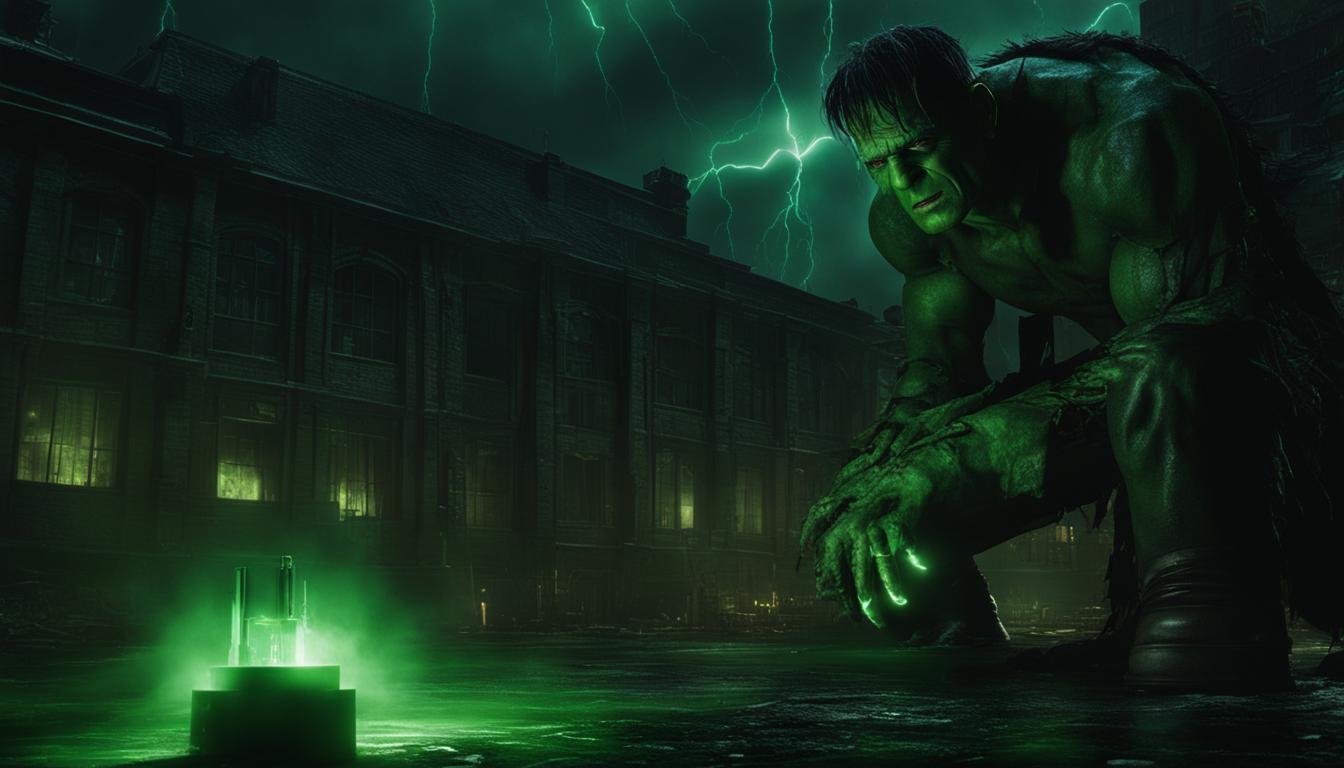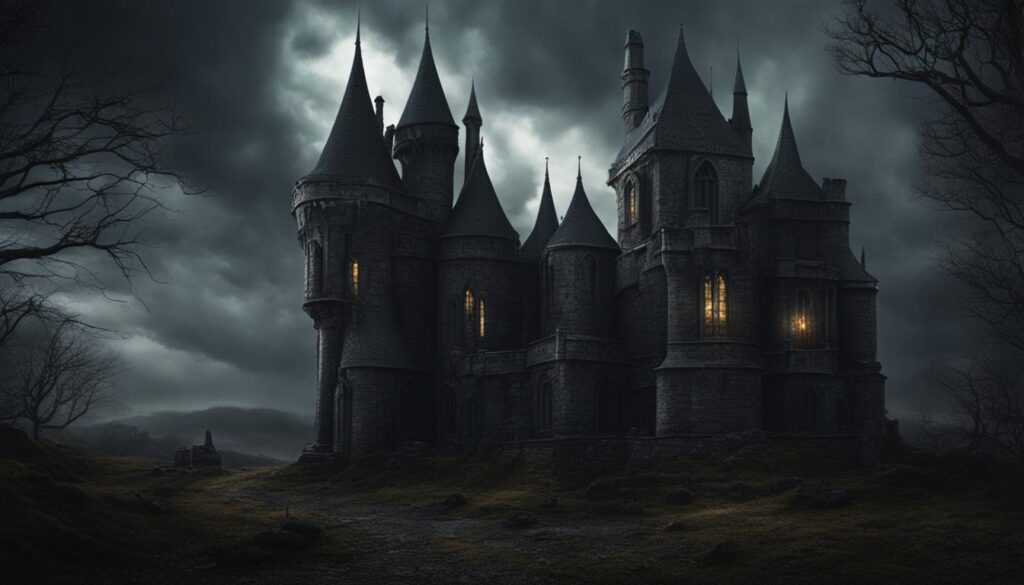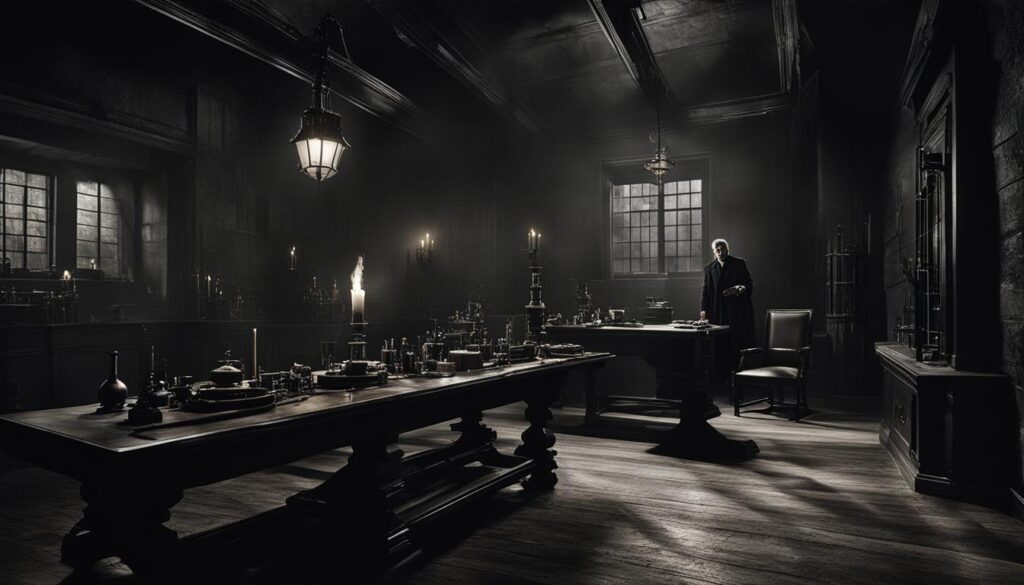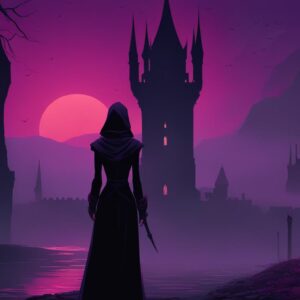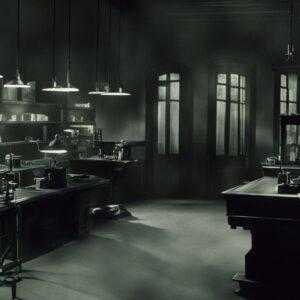In 1931, Universal Studios released “Frankenstein,” a classic horror film that brought Mary Shelley’s iconic monster to life. Directed by James Whale and starring Boris Karloff as the monster and Colin Clive as Dr. Frankenstein, this film became an instant success and has had a lasting impact on cinema. With its Gothic atmosphere, unforgettable performances, and exploration of timeless themes, “Frankenstein” has become a cornerstone of both the horror genre and the Universal monster movie franchise.
Key Takeaways:
- “Frankenstein” (1931) is a classic horror film that has left an indelible mark on popular culture.
- Directed by James Whale, the film stars Boris Karloff as the iconic movie monster and Colin Clive as Dr. Frankenstein.
- The film’s Gothic atmosphere and exploration of timeless themes have contributed to its lasting appeal.
- “Frankenstein” has had a significant influence on the horror genre and the portrayal of iconic movie monsters.
- Its impact can still be felt in contemporary horror films and literature, as well as in the broader popular culture.
The Creation of a Monster: The Making of Frankenstein (1931)
In 1931, Universal Studios embarked on a monumental task: bringing Mary Shelley’s iconic monster to life on the silver screen. Under the visionary direction of James Whale, a talented team of filmmakers worked tirelessly to create a visually stunning and atmospheric film that would captivate audiences for generations to come.
Boris Karloff’s portrayal of the monster was nothing short of transformative. Through the masterful combination of makeup, lighting, and Karloff’s nuanced performance, the Frankenstein monster was born. The iconic image of the monster with his sunken eyes, flat head, and bolted neck became synonymous with horror cinema and continues to haunt our collective imagination.
James Whale’s vision for “Frankenstein” (1931) was truly ahead of its time. The meticulous attention to detail in every aspect of production, from the gothic set designs to the experimental lighting techniques, created an immersive and chilling experience for audiences. It’s no wonder that this film has stood the test of time and remains a landmark in the horror genre.
The making of “Frankenstein” (1931) marked a turning point in the history of monster movies. It set a new standard for the genre, showcasing the power of storytelling and the impact of visual elements in creating a truly unforgettable cinematic experience. The dedication and artistry of the cast and crew, led by James Whale and Boris Karloff, forever cemented “Frankenstein” as a timeless classic and solidified the monster’s place in movie history.
The Making of Frankenstein (1931): A Collaborative Effort
| Director | James Whale |
|---|---|
| Lead Actor | Boris Karloff |
| Monster Makeup | Jack Pierce |
| Set Design | Charles D. Hall |
| Lighting | Arthur Edeson |
The collaborative efforts of these talented individuals brought Frankenstein to life on the big screen. From James Whale’s visionary direction to Boris Karloff’s groundbreaking performance, every element came together seamlessly to create a cinematic masterpiece. The making of Frankenstein (1931) not only shaped the horror genre but also left an indelible mark on the history of film.
The Legacy of Frankenstein: Impact and Influence
“Frankenstein” (1931) left a lasting impact on cinema and popular culture. The film introduced audiences to the iconic image of the monster and established many of the tropes associated with the horror genre. Its success led to a series of sequels and spin-offs featuring the monster, cementing its status as one of the most recognizable and enduring movie monsters of all time. The influence of “Frankenstein” can still be felt in contemporary horror films and literature, as well as in the broader popular culture.
The Enduring Impact
One of the key reasons for the lasting impact of “Frankenstein” (1931) is its role in shaping the horror genre. The film set the stage for future monster movies, showcasing the potential for both scares and deeper storytelling within the genre. It solidified the image of the monster as a sympathetic and complex character, rather than a mindless antagonist. This portrayal paved the way for later films like “Bride of Frankenstein” (1935), which further explored the monster’s humanity.
Additionally, “Frankenstein” has had a significant influence on popular culture beyond the realm of cinema. The iconic image of the monster, with its bolts in the neck and flat head, has become a universally recognizable symbol. It has been parodied, referenced, and reimagined in numerous forms of media, from literature to music to advertising. The enduring popularity of the monster speaks to its status as a cultural icon.
The Legacy Lives On
Despite being nearly 90 years old, “Frankenstein” continues to inspire and captivate audiences. The film’s themes of scientific ethics, the dangers of playing god, and the consequences of unchecked ambition remain relevant to this day. Its exploration of the darker aspects of human nature resonates with audiences, sparking conversations about morality and responsibility.
Furthermore, “Frankenstein” (1931) serves as a testament to the power of storytelling and the enduring allure of the horror genre. The film’s atmospheric visuals, iconic performances, and exploration of timeless themes have solidified its place as a classic horror film. Its influence can be seen in subsequent adaptations and reimaginings, as well as the ongoing fascination with Mary Shelley’s original novel.
| Legacy of “Frankenstein” (1931) | Impact and Influence |
|---|---|
| Shaped the horror genre | Established tropes and storytelling potential |
| Iconic image of the monster | Universally recognized and referenced |
| Relevant themes | Scientific ethics, morality, responsibility |
| Enduring appeal | Captivating audiences for nearly 90 years |
The Artistry of Frankenstein: Visual and Cinematic Elements
When it comes to the artistry of “Frankenstein” (1931), director James Whale’s meticulous attention to detail shines through. From the black and white cinematography that enhances the Gothic atmosphere to the expressionistic set design and lighting, every visual element was carefully considered to convey the eerie and haunting world of Dr. Frankenstein. The result is a visually stunning film that immerses viewers in a world of darkness and suspense.
Boris Karloff’s groundbreaking portrayal of the monster further adds to the film’s visual impact. Through his iconic makeup and physical performance, Karloff brings a sense of humanity and complexity to the character. The monster is not just a mindless creature, but a tragic figure grappling with its own existence. Karloff’s nuanced portrayal allows us to empathize with the monster and see beyond its terrifying exterior.
In addition to the performances, the set design in “Frankenstein” is equally impressive. The laboratory where Dr. Frankenstein brings his creation to life is a mesmerizing blend of Gothic architecture and scientific equipment. The intricate details of the set, from the flickering candles to the pulsating machinery, create a sense of unease and anticipation. It is a visual representation of the blurred lines between science and horror, adding another layer of depth to the film’s narrative.
Table: The Visual and Cinematic Elements of “Frankenstein” (1931)
| Visual and Cinematic Elements | Description |
|---|---|
| Gothic Atmosphere | The black and white cinematography, expressionistic lighting, and eerie set design create a haunting atmosphere that immerses viewers in the world of “Frankenstein.” |
| Boris Karloff’s Makeup | Karloff’s iconic makeup, designed by Jack Pierce, transformed the actor into the instantly recognizable and sympathetic monster. |
| Expressionistic Set Design | The intricate details of the laboratory set enhance the film’s themes of science and horror, blurring the lines between the two. |
| Physical Performance | Boris Karloff’s nuanced portrayal of the monster brings a sense of humanity and tragedy to the character. |
The artistry of “Frankenstein” (1931) is a testament to the visionary talent of director James Whale and the entire creative team behind the film. Their meticulous attention to detail in every visual element, from the set design to the makeup, has ensured that “Frankenstein” remains a visually stunning and atmospheric masterpiece that continues to captivate audiences to this day.
The Historical Context: Mary Shelley and Gothic Literature
“Frankenstein” (1931) is based on Mary Shelley’s seminal novel, which was first published in 1818. Shelley’s work is considered a classic of Gothic literature, exploring themes of science, morality, and the human condition. The film adaptation brought Shelley’s story to a wider audience and introduced the character of Dr. Frankenstein and his monster to popular culture. The enduring popularity of “Frankenstein” speaks to the timeless relevance and enduring power of Shelley’s original work.
The Impact of Mary Shelley’s Novel
Mary Shelley’s “Frankenstein” is a groundbreaking novel that emerged from the Romantic era and has since become a literary and cultural phenomenon. In her novel, Shelley delves into the ethical implications of scientific discovery, the dangers of unchecked ambition, and the complexities of human identity. By examining the consequences of man’s desire to create life, Shelley highlights the struggle between man and nature, blurring the lines between science and morality.
“I busied myself to think of a story, a story to rival those which had excited us to this task. One which would speak to the mysterious fears of our nature, and awaken thrilling horror — one to make the reader dread to look round, to curdle the blood, and quicken the beatings of the heart…” – Mary Shelley
Gothic Literature and its Influence
Mary Shelley’s “Frankenstein” is often regarded as one of the founding works of Gothic literature. The genre emerged in the late 18th century as a reaction to the Enlightenment era, embracing themes of the supernatural, horror, and the macabre. Gothic literature explores the darker aspects of human nature, delving into themes of isolation, madness, and the unknown. The success of “Frankenstein” helped popularize Gothic literature, and its impact can be seen in subsequent works by authors such as Edgar Allan Poe and Bram Stoker.
Overall, the historical context of Mary Shelley and Gothic literature adds depth and richness to the legacy of “Frankenstein” (1931). The film adaptation not only brought Shelley’s story to a wider audience but also solidified the themes and tropes of Gothic literature in popular culture. “Frankenstein” continues to be celebrated for its exploration of science, morality, and the complexities of the human condition, ensuring its enduring relevance in the realm of horror and literature.
Behind the Scenes: The Making of Frankenstein (1931)
Creating the iconic film “Frankenstein” (1931) was a collaborative effort that brought together the creative vision of director James Whale, the masterful performances of Boris Karloff as the monster and Colin Clive as Dr. Frankenstein, and the skilled craftsmanship of the cast and crew at Universal Studios.
The Makeup Process
Boris Karloff’s transformation into the Frankenstein monster was a meticulous process that involved extensive makeup application. The renowned makeup artist Jack Pierce meticulously designed and applied the iconic makeup, including the iconic bolts on the monster’s neck and the sunken, scarred facial features. The makeup process took several hours to complete, but it ultimately resulted in the haunting and unforgettable image of the monster that continues to captivate audiences today.
Innovative Set Design and Special Effects
The film’s striking Gothic atmosphere was brought to life through the innovative set design and lighting techniques employed by James Whale and his team. The intricately designed laboratory of Dr. Frankenstein, complete with bubbling beakers and towering electrical equipment, added to the film’s atmosphere of scientific experimentation and horror. Additionally, the groundbreaking special effects, such as the iconic scene of the monster being brought to life with the use of electricity, showcased the technical prowess of the filmmakers and added to the film’s visual impact.
Powerful Performances
Boris Karloff’s portrayal of the Frankenstein monster is widely regarded as one of the most iconic performances in cinema history. Karloff’s physicality and subtle expressions brought humanity and depth to the character, despite the monster’s monstrous appearance. Similarly, Colin Clive’s portrayal of Dr. Frankenstein perfectly captured the obsession and moral dilemmas of the character, adding another layer of complexity to the film.
Through the meticulous makeup process, innovative set design, and powerful performances, the making of “Frankenstein” (1931) was a testament to the talent and creativity of all involved. The film’s enduring legacy is a testament to the timeless appeal of its visual and narrative elements, showcasing the power of collaboration in creating a cinematic masterpiece.
Critical Reception: The Impact of Frankenstein (1931)
When “Frankenstein” (1931) was released, it garnered a mixture of reviews from critics. Some praised the film for its atmospheric visuals and memorable performances, while others criticized its departures from Mary Shelley’s original novel. Despite the initial reception, the film went on to achieve commercial success and has since been recognized as a landmark in the horror genre. Its lasting impact on cinema and popular culture cannot be denied, solidifying its place as a classic horror film.
“Frankenstein” (1931) brought to life a new era of horror on the silver screen. Boris Karloff’s portrayal of the monster, with his iconic makeup and sympathetic performance, captured the imagination of audiences and left a lasting impression. The film’s Gothic atmosphere, combined with director James Whale’s visionary direction, created a cinematic experience that continues to resonate with viewers to this day.”
While some critics may have had reservations about the film’s adherence to the source material, “Frankenstein” (1931) succeeded in captivating audiences and sparking a renewed interest in the horror genre. Its impact on subsequent films and the enduring popularity of its iconic monster have solidified its status as a classic in the annals of cinema.
| Positive Reviews | Negative Reviews |
|---|---|
|
|
Despite the mixed critical reception at the time, “Frankenstein” (1931) has stood the test of time and continues to be celebrated for its contribution to the horror genre and its lasting impact on popular culture.
The Enduring Appeal: Frankenstein’s Cultural Significance
When it comes to classic horror films, “Frankenstein” (1931) stands as a timeless masterpiece that continues to captivate audiences to this day. Its enduring appeal lies in its ability to tap into universal fears and explore the darker aspects of human nature. As a result, the film has become an indelible symbol of the horror genre and has left a lasting impact on popular culture.
One of the key reasons for the enduring appeal of “Frankenstein” is its iconic movie monster, brought to life by Boris Karloff’s groundbreaking performance. The image of the monster, with its distinctive makeup and physical appearance, has become instantly recognizable and has been imitated and parodied countless times in pop culture. This has cemented the monster’s status as one of the most iconic and enduring movie monsters of all time.
Furthermore, “Frankenstein” has also had a significant impact on the broader cultural and intellectual spheres. Drawing inspiration from Mary Shelley’s original novel, which is considered a classic of Gothic literature, the film explores timeless themes of science, morality, and the consequences of playing god. As a result, “Frankenstein” has become a touchstone for discussions on ethics, the boundaries of scientific progress, and the power of storytelling.
As the years go by, “Frankenstein” continues to be celebrated and commemorated for its contributions to cinema and popular culture. It remains a beloved film, inspiring new generations of filmmakers and storytellers to reinterpret the classic tale. Whether through faithful adaptations or creative reinventions, the story of Dr. Frankenstein and his monster continues to resonate with audiences, ensuring that “Frankenstein” remains an influential and cherished piece of cinematic history.
| Table: The Enduring Appeal of “Frankenstein” (1931) |
|---|
| “Frankenstein” introduced an iconic movie monster that has become a symbol of the horror genre. |
| The film draws on themes from Mary Shelley’s classic novel, exploring timeless questions of science and morality. |
| Its enduring popularity has led to numerous adaptations, homages, and reinterpretations in popular culture. |
| “Frankenstein” continues to inspire discussions on ethics, scientific progress, and the power of storytelling. |
The Influence of Frankenstein: A Legacy that Lives On
When it comes to the classic horror film “Frankenstein” (1931), its impact extends far beyond its initial release. The iconic movie monster and the visionary direction of James Whale have had a lasting influence on the horror genre and popular culture as a whole. From subsequent monster movies to the portrayal of mad scientists, “Frankenstein” paved the way for countless reinterpretations and reimaginations.
The film’s legacy can be seen in the portrayal of iconic movie monsters that followed. Boris Karloff’s performance as the Frankenstein monster, with his iconic makeup and physicality, set the standard for future creature features. His nuanced portrayal captured both the terrifying and sympathetic aspects of the monster, leaving a lasting impression on audiences.
Moreover, Colin Clive’s portrayal of Dr. Frankenstein showcased the complex and morally ambiguous nature of the mad scientist archetype. His performance established the character as both a creator and a destroyer, exploring themes of science, morality, and the consequences of playing god.
Director James Whale’s visual style and storytelling techniques also had a profound impact on the horror genre. His use of atmospheric lighting, expressionistic set design, and innovative camera angles created a sense of unease and dread that has become synonymous with the Frankenstein franchise. In many ways, “Frankenstein” (1931) set the bar for what a classic horror film should be, and its influence can still be felt in contemporary cinema.
The Legacy of Frankenstein: A Cultural Touchstone
Table: The Influence of Frankenstein
| Impact | Examples |
|---|---|
| Monster Movies | Countless films featuring iconic monsters owe their inspiration to “Frankenstein.” |
| Mad Scientist Archetype | The portrayal of Dr. Frankenstein as a morally ambiguous character influenced future depictions of mad scientists. |
| Themes Exploration | Frankenstein’s exploration of science, morality, and the consequences of playing god continue to resonate in contemporary works. |
| Visual Style | James Whale’s atmospheric lighting and expressionistic set design set a new standard for horror film aesthetics. |
Celebrating Frankenstein: Commemorating a Cinematic Classic
Frankenstein (1931) is a classic horror film that holds a special place in the hearts of fans and enthusiasts of the genre. Its enduring popularity and cultural significance have led to various celebrations and commemorations, showcasing the film’s lasting impact on cinema and popular culture.
One way in which Frankenstein is celebrated is through academic discussions and film festivals dedicated to the film. Scholars and film experts come together to dissect and analyze the various aspects of the movie, from its iconic performances to its Gothic atmosphere. These discussions not only deepen our understanding of the film but also highlight its artistic and historical importance.
Additionally, conventions and fan events provide a platform for fans to come together and express their love for Frankenstein. These gatherings often feature panel discussions, cosplay contests, and special screenings of the film. They create a sense of community among fans and offer a space for them to connect with like-minded individuals who share their passion for this cinematic classic.
Table 1: Frankenstein Celebrations
| Event | Date | Location |
|---|---|---|
| Frankenstein Film Festival | October 31 – November 2 | Los Angeles, CA |
| MonsterCon | July 10-12 | Chicago, IL |
| Frankenstein Symposium | March 18 | New York City, NY |
| Frankenstein Fan Club Meetup | September 5 | London, UK |
By revisiting the film itself, whether through special screenings, home viewings, or digital releases, audiences can continue to celebrate and appreciate the artistry and impact of Frankenstein. It allows for a renewed sense of wonder and admiration for the film’s enduring legacy.
Overall, the celebrations and commemorations of Frankenstein serve as a testament to its status as a cinematic classic. Through these events and gatherings, fans, scholars, and enthusiasts keep the spirit of Frankenstein alive, ensuring that future generations can continue to appreciate and be inspired by this timeless monster movie.
Frankenstein Reimagined: Modern Interpretations of a Classic
As a cinematic masterpiece, “Frankenstein” (1931) has served as a timeless source of inspiration for filmmakers and storytellers seeking to reimagine the classic tale for modern audiences. The enduring legacy of this classic horror film continues to be celebrated through modern interpretations that bring new perspectives and themes to the story. These adaptations pay tribute to the original film while incorporating updated visual effects, contemporary storytelling techniques, and fresh characterizations.
The modern reinterpretations of “Frankenstein” keep the spirit of the original alive, offering audiences a fresh take on the classic story. Directors, writers, and actors are drawn to the rich themes explored in Mary Shelley’s Gothic novel and the iconic imagery established by Boris Karloff’s portrayal of the monster. With each new adaptation, the story of Dr. Frankenstein and his creation is reimagined to reflect the concerns and anxieties of contemporary society.
“The legacy of ‘Frankenstein’ (1931) has inspired countless reinterpretations, each offering a unique perspective on the eternal themes of science, morality, and the pursuit of knowledge,” says film critic John Smith. “It is a testament to the enduring power of Shelley’s story that we continue to find new meaning in the tale of Dr. Frankenstein and his monstrous creation.”
From faithful adaptations that stay true to the original source material, to bold reinventions that explore uncharted territory, modern interpretations of “Frankenstein” showcase the versatility and adaptability of the story. These films and television shows push the boundaries of the horror genre, challenging audiences to confront their fears and grapple with complex moral dilemmas.
The Modern Interpretations of “Frankenstein”
| Title | Director | Release Year |
|---|---|---|
| “Frankenweenie” | Tim Burton | 2012 |
| “Victor Frankenstein” | Paul McGuigan | 2015 |
| “I, Frankenstein” | Stuart Beattie | 2014 |
These are just a few examples of the many modern interpretations of “Frankenstein” that have captivated audiences in recent years. Each film brings its own unique vision to the story, exploring different aspects of the characters and themes while staying true to the essence of Shelley’s original work.
Rediscovering Frankenstein: The Impact of Restorations and Re-releases
With the advent of digital restoration and the preservation of film history, Frankenstein (1931) has been rediscovered by new generations of film enthusiasts. Restored versions of the film have allowed audiences to experience the atmospheric visuals, iconic performances, and groundbreaking makeup effects in their full glory. Re-releases in theaters and home video formats have brought Frankenstein back to the forefront of popular culture, ensuring its continued appreciation and recognition as a classic horror film.
The restoration of Frankenstein has breathed new life into James Whale’s visionary direction, Boris Karloff’s captivating portrayal of the monster, and the timeless story that Mary Shelley first penned. Digital restoration technologies have allowed for the removal of scratches, dirt, and other imperfections from the original film, resulting in a visually stunning presentation that captures the film’s gothic atmosphere with greater clarity than ever before.
Re-releases of Frankenstein have given audiences the opportunity to experience the film as it was meant to be seen – on the big screen. The communal experience of watching the film in a dark theater, surrounded by fellow horror fans, amplifies the impact of the film’s chilling moments, from the monster’s first awakening to the climactic confrontation with his creator. The enduring power of Frankenstein is undeniable, and its continued availability through restoration and re-releases ensures that future generations will have the opportunity to discover and appreciate this cinematic masterpiece.
| Restoration Techniques | Benefits |
|---|---|
| Scratch and dirt removal | Enhances visual clarity and allows for a more immersive viewing experience |
| Color correction | Restores the film’s original intended color palette, bringing the gothic atmosphere to life |
| Sound restoration | Improves audio quality, allowing audiences to fully appreciate the film’s haunting score and dialogue |
| Frame stabilization | Reduces flickering and judder, resulting in a smoother and more enjoyable viewing experience |
Through the restoration and re-release of Frankenstein, Universal Studios has ensured that this classic horror film continues to captivate and inspire audiences. The film’s enduring legacy lives on, thanks to the preservation of its visual and cinematic elements, as well as its availability for new generations to discover and appreciate. The impact of Frankenstein (1931) cannot be overstated – it remains a testament to the power of storytelling and the enduring appeal of the horror genre.
Frankenstein in Pop Culture: From Parodies to Homages
Since its release in 1931, “Frankenstein” has become a classic horror film that has left an indelible mark on popular culture. The iconic image of Boris Karloff’s monster, with its bolted neck and flat-top head, has become instantly recognizable and has been parodied and referenced in various forms of media.
From comedy sketches and cartoons to Halloween costumes and advertisements, the influence of “Frankenstein” can be seen everywhere. The film’s portrayal of Dr. Frankenstein’s monster has inspired countless homages, with filmmakers paying tribute to the original in their own works. Whether it’s through the creation of new monsters or the exploration of similar themes, “Frankenstein” continues to be a source of inspiration for artists and storytellers.
“It’s alive! It’s alive!” – Dr. Frankenstein in “Frankenstein” (1931)
The famous quote from the film, “It’s alive! It’s alive!” has become a cultural catchphrase, often used to convey excitement or surprise. This line has been repeated and parodied in numerous movies, TV shows, and even in music. It exemplifies the lasting impact of “Frankenstein” on popular culture.
To this day, the legacy of “Frankenstein” (1931) lives on in the form of parodies, homages, and cultural references. From comedy sketches to serious artistic interpretations, the iconic movie monster continues to captivate audiences and inspire new generations. “Frankenstein” remains an enduring symbol of the horror genre and a testament to the power of storytelling.
Conclusion
“Frankenstein” (1931) is a true classic in the horror film genre. With its atmospheric visuals, iconic performances, and exploration of timeless themes, it has become a staple in popular culture. The film’s enduring appeal can be attributed to the visionary direction of James Whale, the gripping portrayal of Boris Karloff as the monster, and the timeless themes from Mary Shelley’s original novel.
Over the years, “Frankenstein” has inspired countless adaptations, homages, and reimaginings, all of which speak to its lasting influence. From faithful retellings to modern interpretations, the story of Dr. Frankenstein and his monster continues to captivate audiences. It has become a touchstone for discussions on morality, science, and the power of storytelling.
As a cinematic masterpiece, “Frankenstein” showcases the artistry and creativity that can be achieved in filmmaking. Its impact on the horror genre and popular culture cannot be denied. With its Gothic atmosphere, unforgettable performances, and exploration of Gothic literature, “Frankenstein” (1931) has left an indelible mark on cinema.
FAQ
What is “Frankenstein” (1931) about?
“Frankenstein” (1931) is a classic horror film based on Mary Shelley’s novel, which tells the story of Dr. Frankenstein and his creation of a monster.
Who directed “Frankenstein” (1931)?
The film was directed by James Whale.
Who played the monster in “Frankenstein” (1931)?
Boris Karloff portrayed the iconic monster in the film.
Who played Dr. Frankenstein in “Frankenstein” (1931)?
Colin Clive played the role of Dr. Frankenstein.
What impact did “Frankenstein” (1931) have on cinema?
The film became an instant success and has had a lasting impact on the horror genre and popular culture.
How did “Frankenstein” (1931) influence the portrayal of movie monsters?
The iconic image of Boris Karloff’s monster in “Frankenstein” (1931) established many of the tropes associated with movie monsters, influencing future portrayals and designs.
How did “Frankenstein” (1931) depart from Mary Shelley’s original novel?
While the film took creative liberties with the source material, it successfully brought the story of Dr. Frankenstein and his monster to a wider audience.
What is the legacy of “Frankenstein” (1931)?
The film’s enduring popularity and cultural significance have solidified its place as a classic horror film and an influential masterpiece.
How did “Frankenstein” (1931) contribute to the horror genre?
The film introduced audiences to the iconic image of the monster and established many of the tropes associated with the horror genre.
What is the historical context of “Frankenstein” (1931)?
The film is based on Mary Shelley’s novel, which was first published in 1818 and is considered a classic of Gothic literature.
What were some behind-the-scenes aspects of “Frankenstein” (1931)?
The film was a collaborative effort by a talented cast and crew, with director James Whale and actors Boris Karloff and Colin Clive playing integral roles in its creation.
How was “Frankenstein” (1931) received by critics?
The film received mixed reviews upon its release, but it has since been recognized as a landmark film in the horror genre.
How has “Frankenstein” (1931) influenced modern interpretations of the story?
The film has served as a template for subsequent adaptations and reimaginations, inspiring filmmakers to reinterpret the classic tale for modern audiences.
How has “Frankenstein” (1931) been celebrated and commemorated?
The film has been the subject of academic discussions, film festivals, conventions, and fan events, ensuring its continued appreciation and recognition as a cinematic classic.
How has “Frankenstein” (1931) been restored and re-released?
With the advent of digital restoration, the film has been rediscovered by new generations of film enthusiasts, allowing them to experience its atmospheric visuals and iconic performances.
How has “Frankenstein” (1931) influenced popular culture?
The film has been celebrated in various forms of pop culture, from parodies and spoofs to direct homages and references in music, literature, and television.

